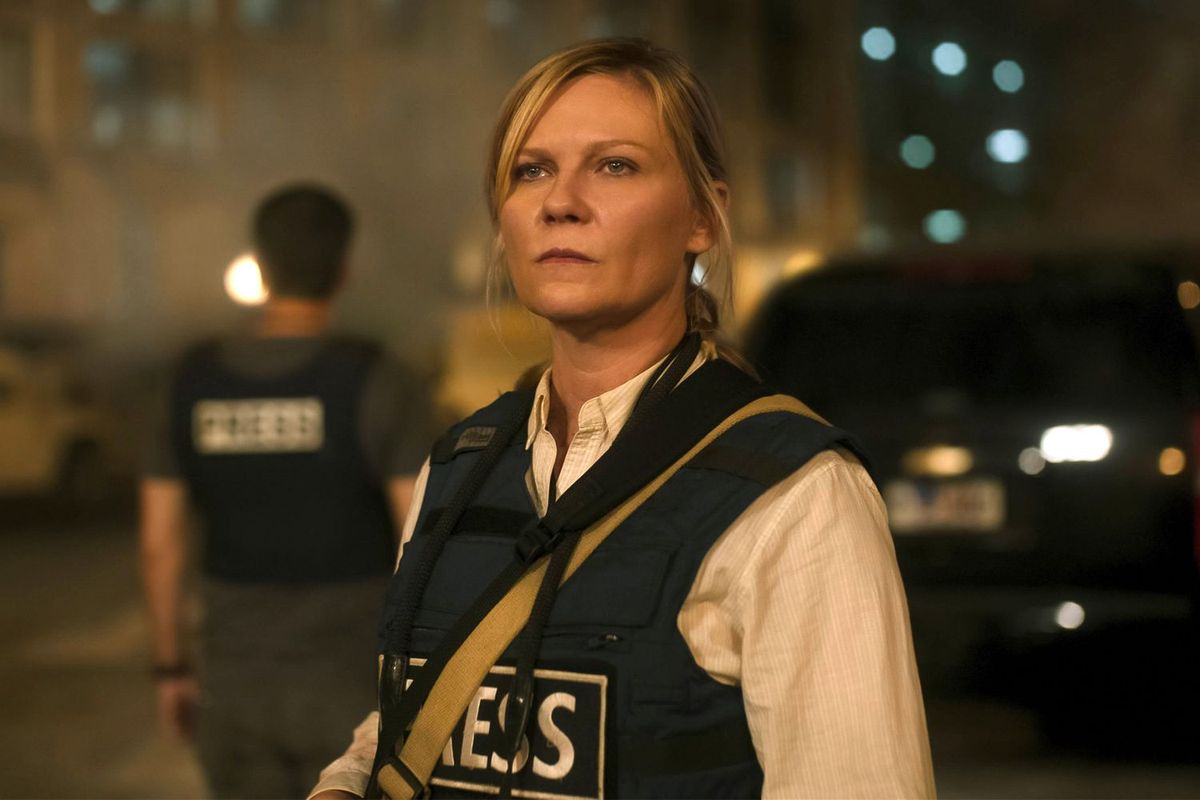Film Society x The Student: “Civil War”
Chris Tun ’25 reviews Alex Garland’s controversial new film “Civil War,” describing it as a haunting but politically avoidant depiction of war on American soil.

If you are expecting a movie that explores the political implications of a second American Civil War, then Alex Garland’s recently released film “Civil War” is surprisingly not for you. The reason behind the titular war and the grievances of the secessionist states are never discussed besides some remarks made by various characters. Even the sides of various combatants shown remain unclear in some crucial scenes. Overall, politics are distant from the core of this narrative, which may be to the dismay of some, but Garland has repeatedly stated that the film’s focus isn’t necessarily on current political polarization. The film focuses instead on the role and place of embedded journalism in war, presenting the importance but also criticisms of the career. By placing the violence seen internationally in a domestic setting, Garland cuts through to a desensitized audience who has experienced said violence through the constant stream of news. The film reminds its audience the true weight of war and its violence through its horrific imagery, though its effect may be lost to the film’s apolitical nature for some.
“Civil War” begins in the middle of the war as the current authoritarian president (Nick Offerman) prepares for a speech discussing recent victories over the Western Forces and the Florida Alliance, regions of the United States that had seceded. Watching this speech in her hotel room, news photographer Lee Smith (Kirsten Dunst), who shares her name with Lee Miller, a World War II photographer, takes a photo of the president on her television, as an explosion can be seen in the city skyline in the background through a sliding door.
Alongside Reuters reporter Joel (Wagner Moura), The New York Times veteran journalist Sammy (Stephen McKinley Henderson), and young freelance photographer Jessie Cullens (Cailee Spaeny), Lee races to Washington, D.C. to interview and photograph the president before the inevitable fall of the capital to the Western Forces and the Florida Alliance. During their tense journey, they encounter horrifying scenes and face heavy losses, all within domestic American settings such as golf courses and rural gas stations.
As the crew gets closer to D.C., the horrors of war become more present as they witness war crimes and mass graves, though both Lee and Jessie do not hesitate to take photos. Eventually, they find themselves at the White House, where the film ends in a tense climax. This narrative structure reminds me of Francis Ford Coppola’s 1979 classic “Apocalypse Now,” as both films depict the horrors of war through their protagonist’s journey to a certain destination. Like “Apocalypse Now,” “Civil War” also pays attention to the eyes that see said horrors.
Lee is a seasoned news photographer, which the film reveals through traumatic flashbacks to her time overseas covering different conflicts and taking disturbing photos. Her trauma from this time has clearly festered within her, though she does not communicate this pain with others. Acting almost like a younger version of Lee, Jessie Cullens is new to this line of work and admires Lee and her long career. The two women’s relationship appears almost like Lee trying to talk her younger self out of the shortsightedness that led to her lasting trauma, but Jessie seemingly ignores this advice and becomes more engaged in covering the conflict and risking her life for photos.
This cycle of trauma thus continues, and the film raises questions about the role of journalism in the warzone. Capturing this senseless violence not only exploits its subjects and the violence they face but also threatens the lives of the photographers themselves. Although news photography can be motivated by preventing further violence, these photos can only hope to spark a conversation between viewers, since prevention of violence requires a dialogue for peace. Following a similar line of thought as a news photographer, Garland shows his audience the horrors of this violence through grotesque displays of inhumane acts hoping to begin said dialogue.
One scene shows Lee taking a photo of an armed young man between two looters who had been beaten, tortured, and hung up in a carwash. Lee’s apathy to the gravity of this horrific sight is jarring and her photography almost exploits the violence. However, the audience eventually sees that Lee has almost become disillusioned with the practice, saying that she had hoped that the photos she took overseas would have dissuaded the United States from such violence. Jessie, new to the craft, has yet to come to such a conclusion. As seen in her increasingly violent photos, Jessie is becoming more embedded in the conflict and increasingly takes more risks, which leads to some notable losses in the crew.
Both Dunst and Spaeny’s portrayal of these characters makes this dynamic feel more realistic and tragic. Dunst’s performance subtly yet profoundly depicts her character’s trauma and its effect on her. Moura’s performance as Joel, as he screams in anguish over the loss of a close friend, also convincingly shows how the horrors of war might push someone to a breaking point. Henderson, as Sammy, allows Lee to openly discuss the role of journalism in war, as his character provides important insight into the role of a journalist in times of conflict, warning those motivated like Lee to step back before something tragic happens.
One notable scene features Dunst’s husband and fellow actor Jesse Plemons in a tense standoff between xenophobic militants and the news crew. Plemons’s performance as one of the militants is off-kilter and almost psychopathic, which is clearly the result of the horror of war and its psychological impact. The scene leaves audiences terrified by the character and his unpredictable actions, which Plemons portrays excellently.
The cinematography and sound design of the film stood out in various moments. In one scene, the crew is stuck in a sniper standoff in an abandoned Christmas display. As the natural ambiance mixes with a holiday tune from a speaker, the camera shifts in focus from the sniper and the flowers on the grass next to them. In another scene, the crew covers a tense shoot-off between militiamen and loyalist soldiers. The color grading of the scene is close to reality and almost like a documentary. The gunshots in the scene are startling, especially in a theater and its surround sound. The film shifts seamlessly between the serene and the violent.
The film’s selected soundtrack adds to the overall ominous feeling of the film, with some selections reminiscent of the dark psychedelic track “The End” by The Doors, a track that is heard at the beginning of “Apocalypse Now.” The two tracks by musical duo Suicide are particularly memorable. “Rocket U.S.A.” and “Dream Baby Dream” bookend their journey, the latter being played out into the credits. The reverberated synths and vocals make these tracks feel ghostly, playing into the tone of the film. The original soundtrack composed by Ben Salisbury and Geoff Barrow also contributes to the sorrow seen throughout the film, with some tracks adding to the misery of the world of “Civil War.”
The war in “Civil War” makes one reflect on the current political polarization as the United States gets closer to the 2024 election. Although the film avoids discussing this polarization explicitly, as Garland himself says that the film could have taken place in a different country, it’s difficult to separate its concept from our current political state. While some Americans fear a civil war based on either candidate winning, the war in this film isn’t a prediction of that fear.
Garland approached the film with the purpose of exploring journalism in wartime, but his message isn’t entirely clear by the time of the credits. Despite this issue, the film’s action sequences and wartime displays are simultaneously stunning and horrifying as the audience sees violence on the homefront. The film is an important watch this year, forcing us to reflect on the evils of war and the need to prevent violence.





Comments ()